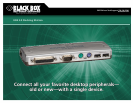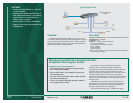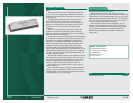
3 of 3
8/17/2007
#26794
724-746-5500 blackbox.com
Item Code
USB 2.0 Docking Station IC662A
✦
USB 2.0 Docking Station
✦
Switching power adapter
✦
USB 2.0 cables
✦
Software CD driver
✦
User’s manual
WHAT‘S INCLUDED
USB.
USB’s main attraction is that it makes adding peripherals
to your computer incredibly easy. It enables you to connect
peripherals to the outside of the computer so you don’t have
to open your PC.
A USB peripheral simply plugs right into the port and
works. You don’t need to install a card; you don’t even
need to turn off your computer. Because USB configuration
happens automatically, built-in USB means you don’t have
to fiddle with drivers and software when adding most
peripherals.
USB 1.1, the original USB standard, has two data rates:
12 Mbps for devices such as disk drives, which need high-
speed throughput, and 1.5 Mbps for devices such as joysticks,
which need much lower bandwidth.
In 2002, USB 2.0, Hi-Speed USB 2.0, gained wide acceptance
in the industry. It increases the speed of the peripheral-to-PC
connection from 12 Mbps to 480 Mbps, or 40 times faster
than USB 1.1. This increase in bandwidth enhances the use
of external peripherals that require high throughput, such
as CD/DVD burners, scanners, digital cameras, and video
equipment. USB 2.0 also supports demanding applications
where multiple high-speed devices run simultaneously, such as
Web publishing. A USB 2.0 host will work with both USB 2.0
and USB 1.1 peripherals. USB 2.0 also supports Windows
®
XP
through a Windows update.
Another USB standard, USB On-The-Go (USB OTG), has also
been developed. USB OTG enables devices other than a PC to
act as a host. It enables portable equipment—such as PDAs,
cell phones, digital cameras, and digital music players—to
connect to each other without the need for a PC host.
There are four types of USB connectors: Type A, Type B,
Mini B, and Mini A.
USB 1.1 specifies the Type A and Type B. USB 2.0 specifies
the Type A, Type B, and Mini B. The Mini A connector was
developed as part of the USB OTG specification and is used for
smaller peripherals, such as cell phones.
Technically Speaking
Technically Speaking
Connecting peripherals with USB.
Before Universal Serial Bus (USB), adding peripherals
required skill. You had to open your computer to install a card,
set DIP switches, and make IRQ settings. Now you can connect
digital joysticks, scanners, speakers, cameras, or PC telephones
to your computer instantly. With USB, anyone can make the
connection because everything is automatic!
Because USB connections are hot-swappable, you can
attach or remove peripherals without shutting down your
computer. Also, USB hubs have additional ports that enable
you to daisychain multiple devices together. More than
800 leading PC, peripheral, and software manufacturers
support USB.





